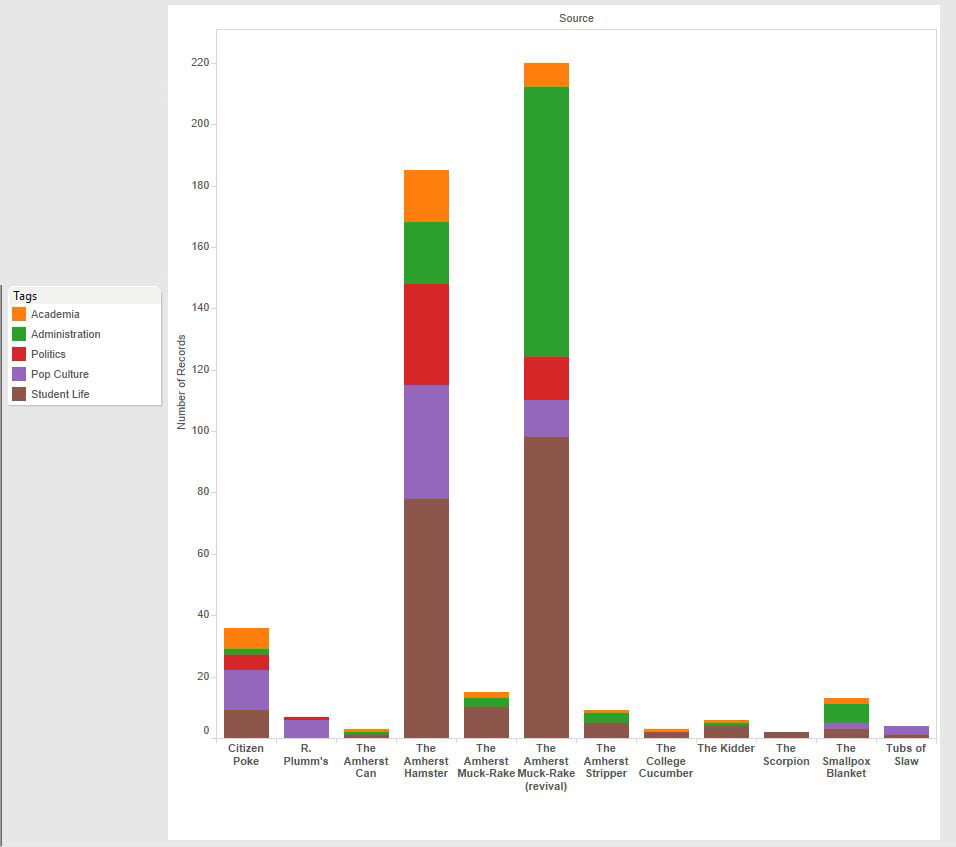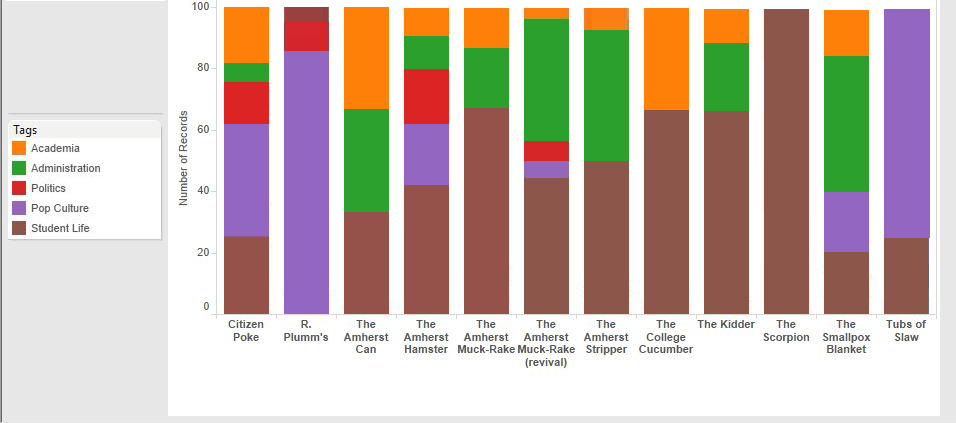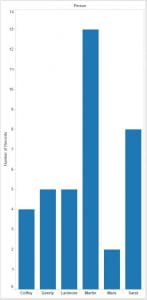Although the TimeMapper is enjoyable, it doesn’t tell us that much about Amherst publications at a glance. Using cleaned data, I was able to generate some more all-encompassing statistics using the free data visualization software, Tableau. Hold tight for some armchair analysis.
Content
As we can see, the Hamster and Muck-Rake dominate the number of contributed pieces, due to their long runs and frequent publishing. A more apt, although equally skewed, representation would be the proportions of each publication’s content.
Unsurprisingly, the majority of the early publications (19th century and 1910s) were primarily concerned with student life and academia. Considering the lack of a unified, mass American “pop culture” at the time, this is understandable.
Tubs of Slaw (1975), Citizen Poke (1994), and R. Plumm‘s (1998) stand out as the oddballs of Amherst publications. Their majority of their content is concerned with pop culture. The death of the “Hillbilly Network” (a surge of sitcoms that glorified traditional, southern life) and shifted emphasis on iconic characters during 70s television are one possible explanation for Tubs of Slaw‘s make-up (as well as their lengthy music reviews section).
Citizen Poke and R. Plumm’s high popular cultural rate most likely stems from their format. Their dedication to the faux-publication theme caused them to focus on fictional institutions and locations. Citizen Poke‘s internet branding and multi-college contribution would force the pub to look at more than just Amherst and college life. Plumm‘s, as an imitation of New Yorker, had little reason to discuss college life in a faux magazine for elites.
The Hamster (2002-2005) would slightly dampen the emphasis on pop culture in order to bring in politics. An obvious cause of this change was 9/11 and the advent of the Iraq war- the Hamster was founded in early 2002. This shifted perspective was both national and global. Other publications at the time seem to share this outward point of view.
In the gap between the Hamster and Muck-Rake (2012), attention seems to have swung inward. Now, the emphasis is placed on administration, with name-dropping precision towards particular figures. The role of Amherst in national news during the publication’s run leads me to believe that the Muck-Rake directly charts student body’s shift in focus. The founding of the Muck-Rake was a series of articles reacting to the plagiarism of Amherst Professor Carleen Basler, a national controversy. In the year following, Angie Epifano released her account of sexual assault, another national event that spurred multiple articles. Even more recently, the Muck-Rake offered live-blogged content of Amherst Uprising, which once again made national headlines.
Places
This chart depicts the top 26 places mentioned in comedy publications. Campus buildings dominate the list, perhaps unsurprisingly. The Muck-Rake (revival) and Hamster account for the majority of the board leaders, which skews results towards more modern structures. In contrast, older publications aimed their targets at Johnson chapel- almost every publication took the chance to ridicule early morning service.
However, the two non-Amherst locations that maintain high mentions are the White House and Iraq. Both support that 1990s and early 2000s publications were politically minded with an outward looking view. Earlier I speculated that the Hamster was so political due to the outbreak of the Iraq war- that data seems to support my case.
People
Finally, a crowd-pleaser: the official tally of which figures in Amherst publication history have been most ruthlessly mocked. The winner (or loser) is President Biddy Martin, by a clear margin. It is not, of course, safe to say that President Martin is the least disliked person on campus. Rather, she has been the current President under the revival Muck-Rake, which boasts much more content and has a much higher rate of reference to specific campus figures. Martin has also interacted with the Muck-Rake, referencing them in emails as well as admitting her appreciation in graduation speeches.
Some runner ups:
- Dean Larimore has the most references per time spent on campus (the majority of which are simply referencing his profile picture)
- Professor Sarat has had the longest history of appearances, first showing up in May of 2002 (and into the early 80s if we include April Fools issues of the Amherst Student).
- Although Tony Marx has the fewest mentions (the result of running the college in the Hamster’s dwindling years), he is also the only to receive mentions that outlast his run at the college.
- Although not on the chart, the Muck-Rake managed to hit this intern pretty hard with a fitting article on the “offline” Muck-Rake, having used those exact resources for this study.
Campus Comedy | Overview of Comedy Publications | The TimeMap | Trends
Project by William Harvey ’18



